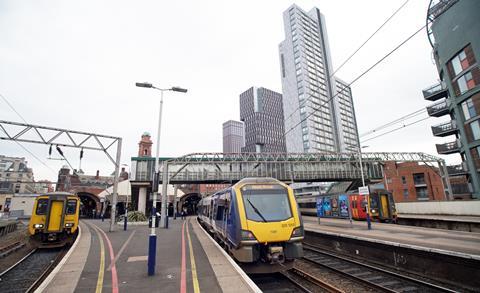
UK: An £84m package of work to improve performance and capacity in Greater Manchester and neighbouring regions was announced by Rail Minister Wendy Morton during a visit to Manchester on March 11.
The interventions include platform extensions, infrastructure enhancements and depot capacity improvements in what the Department for Transport calls the beginning of ‘a decade’s worth of investment that will transform rail in northern England’.
Put together on the basis of work undertaken by the Manchester Rail Recovery Task Force over recent months, the package includes £16∙8m for a two-phase package intended to ensure the upcoming December 2022 timetable is resilient.
The package covers track improvements on the Manchester – Liverpool route via Earlestown, and platform extensions at four stations in Cumbria — Dalton, Kents Bank, Oxenholme and Staveley — which will start this summer and be complete by December.
Ahead of the transfer of more Class 323 EMUs from West Midlands Trains to Northern to facilitate six-car operation, a £41∙5m allocation will fund depot improvements and 17 platform extensions on the Chat Moss, Bolton and Styal lines as well as on the Airedale electric routes northwest of Leeds. This work should be completed by summer 2023.
The remaining £26m will go towards design work for improving passenger facilities at Manchester’s Piccadilly and Victoria stations, and planning the re-signalling of the Castlefield Corridor across the city. This would include remodelling of Manchester Oxford Road by the mid-2030s, DfT said.
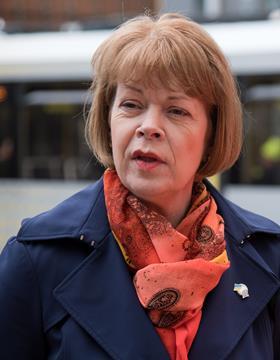
Talking to Rail Business UK, Morton was keen to emphasise that the funding was ‘just the “kick-starting” of a number of projects aimed at resolving performance and capacity problems in Manchester and the north of England.
‘This is very much a part of improving the capacity but [we also need] to improve that passenger experience where we were seeing, in recent years, unacceptable levels of delay and disruption’, she added, reflecting on the capacity constraints in Manchester that had hindered rail service provision across much of Lancashire and Yorkshire prior to the pandemic.
Asked about the pressing need for work in central Manchester in particular, Morton suggested that MRTF had identified ‘how important it was [to unblock] the issue of disruption and delay’, although she declined to elaborate on why it could take up to 13 years to remodel Manchester Oxford Road. ‘It’s about starting to deliver from now, moving right through the next 30 years’, she reiterated.
‘Improving passenger journeys has been at the heart of the rail industry’s hard work to tackle congestion through central Manchester and this investment will mean fewer delays and add 20% more peak-time seats from December 2022’, said Dave Penney, Passenger Strategy Director for Network Rail’s North West & Central region. ‘Network Rail has worked with the whole industry as part of the Manchester Recovery Task Force on how to maximise this £84m investment which promises to boost capacity and improve connectivity across the north of England as part of Britain’s rail recovery.’
Blueprint emerges
One of the key outputs of MRTF’s work to date is a ‘Manchester Blueprint for Services & Infrastructure’, which was presented to the Rail North committee of sub-national body Transport for the North on March 9. This blueprint sets out how the December 2022 timetable change forms a ‘stepping stone’ in a series of enhancements ‘to support reliability and connectivity improvements’.
The committee was told that the blueprint would be ‘a living document, illustrating co-ordinated infrastructure investment and future timetable opportunities’ which will be updated by the task force as schemes progress. It is intended to be delivered in two broad phases, the first from now to 2025 and the second in 2025-40. This takes into account the impact of schemes already funded including the Transpennine Route Upgrade and High Speed 2, while evaluating options for other interventions which are already in development but not yet funded.
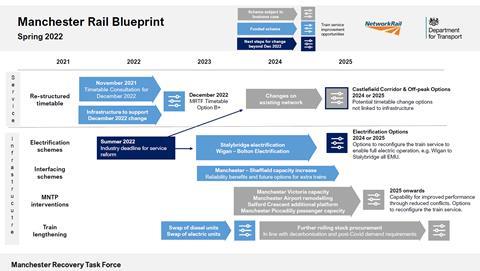
The blueprint splits these interventions into a series of ‘tranches’ to be taken forward by NR following DfT approval. Tranche 1 has already received £26m in funding to allow it to be taken forward to Full Business Case; this funding also allows further development of tranches 2 and 3. As a result, NR has now let design contracts for key Tranche 1 works, including the third platform at Salford Crescent, an east-facing turnback in Salford, a new northwest platform at Manchester Victoria and Manchester Airport station platform lengthening and track layout changes.
Other improvements under consideration for Tranche 1 include a turnback at or near Warrington which would provide more flexibility in the timetable, support additional calls at some stations along the former CLC route between Manchester and Liverpool, and restore cross-Warrington connectivity.
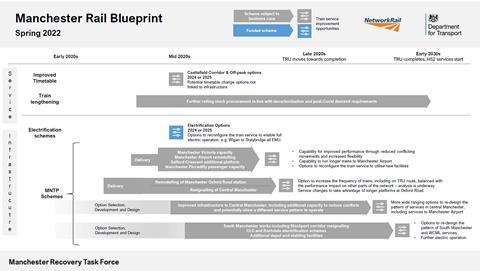
The improvements at Manchester Oxford Road form a key part of the more significant Tranche 2 plan. This would deliver fewer conflicting train movements, longer platforms and improved passenger circulation. The Rail North Committee was told that this work ‘is intended to provide capacity and reliability improvements in the mid-2020s, specifically to remove existing pathing conflicts due to services terminating at Oxford Road and provide capability for longer trains’. However, this contrasts with the longer timescale set out during the ministerial visit two days later.
Platforms revisited
The blueprint explains that work will continue to improve passenger circulation on Manchester Piccadilly’s two existing through platforms, 13 and 14. Meanwhile, a technical report commissioned by TfN will complement this by re-examining the long-standing proposals to add two more through platforms, 15 and 16, ‘should additional performance benefits be identified’.
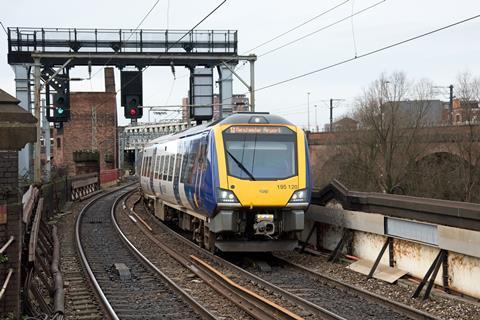
Tranche 3 of the blueprint looks longer term, with a strong focus on the future of Piccadilly as the region’s key passenger hub. Potential options for enhancements include a Platform 0, which may assist in providing additional capacity at the station if blockades are needed elsewhere in the region. MRTF will also work to identify the costs and challenges of remodelling the station throat and grade separating the high-throughput flat junctions immediately south of of the station.
The blueprint also raises the prospect of more electrification around Manchester to maximise the effectiveness of the task force’s infrastructure interventions. It cites the Manchester – Warrington – Liverpool and Manchester Victoria – Rochdale corridors as early candidates with strong outline business cases.
Completion of the already-approved Wigan – Bolton wiring combined with TRU enhancements also raises the prospect of an all-electric service running between Wigan and Stalybridge via Bolton. South of Manchester meanwhile, the blueprint acknowledges that resignalling of the Stockport area will be necessary by the late 2020s, while completion of HS2’s Western Leg to Manchester by 2040 would permit a major recast of local services in this corridor.



